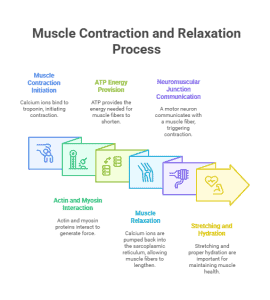Understanding how muscles contract and relax is essential for anyone interested in exploring the anatomy of the muscular system. Muscles play a vital role in movement, stability, and overall functionality of the body. In this section, we will delve into the intricate process of muscle contraction and relaxation.
Muscle Contraction
Muscle contraction is the process by which a muscle generates tension and shortens to produce movement. This process is initiated by a signal from the nervous system, which stimulates the muscle fibers to contract. The key players in muscle contraction are actin and myosin, which are protein filaments found within muscle fibers.
When a muscle is stimulated, calcium ions are released, allowing myosin to bind to actin and form cross-bridges. This interaction causes the muscle to contract and generate force. ATP (adenosine triphosphate) is the energy source that powers this process, providing the necessary energy for muscle contraction to occur.
Muscle Relaxation
After contracting, muscles need to relax in order to return to their original length and prepare for the next contraction. Muscle relaxation is a passive process that occurs when the stimulation from the nervous system ceases. Calcium ions are pumped back into storage, allowing the actin and myosin filaments to separate and the muscle to return to a relaxed state.
During relaxation, ATP is also required to power the process of detaching myosin from actin and restoring the muscle to its resting state. This cycle of contraction and relaxation enables muscles to function efficiently and perform a wide range of movements.
Summary
In summary, muscle contraction and relaxation are fundamental processes that allow muscles to generate force, produce movement, and maintain stability in the body. The interactions between actin, myosin, and calcium ions are crucial for muscle function, and the role of ATP cannot be overstated in providing the energy necessary for these processes to occur. Understanding the mechanisms of muscle contraction and relaxation is essential for anyone studying the anatomy of the muscular system.
Key Takeaways:
- Muscle contraction is the process by which muscles generate force and movement.
- Actin and myosin are the proteins responsible for muscle contraction.
- Calcium ions play a crucial role in initiating muscle contraction by binding to troponin.
- ATP is required for muscle contraction to occur as it provides the energy needed for muscle fibers to shorten.
- Muscle relaxation occurs when calcium ions are pumped back into the sarcoplasmic reticulum, allowing the muscle fibers to lengthen.
- The neuromuscular junction is where a motor neuron communicates with a muscle fiber, triggering muscle contraction.
- Stretching and proper hydration are important for maintaining muscle health and preventing injury.
Key Terms:
- Muscle Contraction: The process by which a muscle fiber generates tension and shortens to produce movement.
- Muscle Relaxation: The process by which a muscle fiber releases tension and returns to its resting state.
- Actin: A protein found in muscle fibers that, together with myosin, plays a key role in muscle contraction.
- Myosin: A protein found in muscle fibers that, together with actin, plays a key role in muscle contraction.
- Sarcomere: The basic unit of muscle contraction, consisting of overlapping actin and myosin filaments.
- Neuromuscular Junction: The point where a motor neuron meets a muscle fiber, allowing for the transmission of signals to initiate muscle contraction.
- Calcium: A key ion involved in muscle contraction, as it triggers the interaction between actin and myosin.
- Tropomyosin: A regulatory protein that blocks the interaction between actin and myosin at rest, and is moved aside during muscle contraction.
- Troponin: A regulatory protein that binds to calcium ions and helps move tropomyosin aside to allow for muscle contraction.
